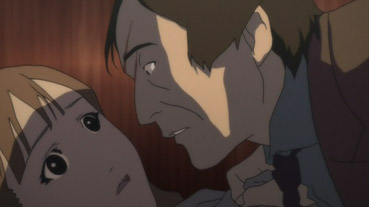|
You gotta have faith. No, I'm not pandering to my girlfriend's iffy music taste and referencing George Michael. When I reviewed Volume 4 of anime series Speed Grapher I expressed a suspicion that the series was starting to soft pedal, to settle into a pattern of recycled narratives in which only the fine detail changed from episode to episode. We've been down this route before with Volume 2, of course, and come Volume 3 I was given cause to eat my suspicions. Looks like it's meal time again.
As before, I'm assuming that if you're reading this you've already seen the previous volumes, as there are going to be spoilers ahead for newcomers. If you're planning to read on regardless then you can prep yourself with my coverage of Volume 1, Volume 2, Volume 3 and Volume 4.

Volume 5's deviation from what was becoming the narrative norm occurs almost as soon as I put the disc in my player. The first of the four episodes included here kicks off with 13-year-old Takeshi and his 8-year-old sister Yui waking one morning to find that their parents have hung themselves. No sooner has Takeshi made the grim discovery than a band of suited corporate gangsters arrive to casually dismiss the suicide and outline the sizeable debt that led to it, a debt that the children are now obliged to work off. Yui is hauled away to who knows where, while Takeshi is indoctrinated into a military training camp to be transformed into a killing machine and sent to war. For 7 years he beats the odds and survives every battle, but his final tour of duty nearly proves fatal when a confrontation with inhuman creatures ends in a catastrophic explosion. The damaged Takeshi is reconstructed from the limbs of others, but the process transforms him in startling and unexpected ways.
If you're new to Speed Grapher then you may, I hope, be intrigued by that outline, but if you know the series then there's a likelihood that you'll be as initially bemused as I was. Seventeen episodes in and, after a short run of stories marked by their similarities, Speed Grapher temporarily but intriguingly sideswipes us with the introduction of new characters in a story strand that bears little relation to main narrative. Or does it? Sharper viewers will doubtless work out what's going on well before the halfway mark, but I was happy to let the episode reveal its secrets at its own pace. Its connection to the main story is clarified in compelling fashion and imbues an offbeat character moment from the previous episode with satisfying retrospective gravitas. It's a dark, well-told story whose series placement is perfectly judged, creatively disrupting a narrative that was drifting towards formula and prompting a rethink of the motivation and role of a character whose path had previously seemed clear.
The subsequent three episodes return us to the main story, but the sidestep taken by episode 17 reinvigorates it and steers it towards a final confrontation that the next and final volume is presumably set to deliver. Suitengu and his cronies are still pursueing Saiga and Kagura, who are quickly snatched to safety by Saiga's old friend Dr. Ryogoku and placed under the care of Ochiai Seiji, a government representative who is also the leader of a secret organisation known as The White Hawk Society. Their plan is to expose the wrongdoings of prime minister Kamiya and his links with Suitengu, and in the process bring down the Japanese government, for which they need Saiga and Kagura's collaboration. Saiga is up for it but doesn't want Kagura involved, despite Professor Nishiya's attempts to emotionally blackmail her cooperation.

Inevitably, Saiga gets to do battle with another Euphoria, but here his usually lethal photographic skills initially prove ineffective, while the Euphoria itself – a human speaker system that uses sound waves to assault the soul – is an impressive creation whose identity has a greater bearing on the plot than most of his predecessors. Pleasingly for this viewer, Ginza snaps out of her alcoholic self-pity and gets back on Saiga's trail, though even she later has the tables turned on her in unexpected and typically kinky fashion. Plot developments also fire up Speed Grapher's socio-political subtext, while its status as an anime for adults is as pronounced as ever, from the dark turns and violence of episode 17 to an attempt to activate the Euphoria virus using the young Kagura's catalytic bodily fluids that almost results in her falling victim to rape.
Speed Grapher, Volume 5 contains episodes 17-20, whose international version titles are as follows (subtitle translation of the Japanese episode titles in brackets): The Reaper and the Nouveau Riche (Death Profiteer), Fates and Fists (Third Bureau), Lips and Lies (Lies and Lips) and Good Vibrations (Good Vibrations). As a four-episode set they effectively blew away my concerns from Volume 4 and re-establish the series as one of the most imaginative and involving doing the UK DVD rounds at the moment. As we move towards the final four episodes, I'm back to rubbing my hands in anticipation.
The 16:9 anamorphic transfer here is consistent with those on previous volumes – a solid NTSC to PAL conversion with good detail and colour and only a slight judder on fast movement.
As before, the English 5.1 mix is sonically superior to the original Japanese 2.0 stereo track, especially in the episode Good Vibrations, which is all about assaulting the audience with noise. That said, I was expecting a little more action from the subwoofer during Saiga's battle with the human speaker system. The language on the English dub is toughened up to include a lot more swearing than the original. I still prefer the voice work on the Japanese track.
Kei Saito Documentary, Part 2 (31:23)
The second instalment of a three-part documentary following voice actor Kei Saito from her first audition to her work on the series as the voice of Kagura. This episode focuses on the PR duties required of her even before she gets into the recording studio, work that includes 10-hour days of interviews and photo shoots, filming a cheesy commercial for the series, attending conventions and publicity events, and standing on street corners handing out flyers to often disinterested passers-by for hours on end. If you think the life of an anime voice artist looks rather glamorous in a country where the position caries status, then this should bring you back down to earth. Interesting in itself, the programme is surprisingly up front about the manufactured element of Saito's public image and makes intriguing viewing for that alone.
Character Cast Auditions (10:30)
Our regular audio date with Christopher Bevins, voice director of the English language version, who introduces snippets from the audition tapes of four of the cast members, namely Aaron Dismuke, Trina Nishimora, Kent Williams and Barry Yandell, who play Takeshi, Yui, Dr. Ryogoku and Professor Nishiya respectively. Bevins is as genial as ever and usefully provides comparisons with other readings, but this is definitely one to save for after you've seen the show, as there are character spoilers for newcomers. Even then you're not completely safe – I learned something here about volume 6 that I'd rather not have known yet.
There's also an Art Gallery (1:48) consisting of a short and rather pointless rolling gallery of frame grabs set to music, the usual Textless Opening (1:33) and Textless Closing (1:33), and Trailers for Gun Sword (1:37) and Black Cat (1:31).
Volume 5 of Speed Grapher did just what I had hoped it would, dispelling reservations set up by Volume 4 and launching the series most effectively towards its next volume finale. As with Volume 4, MVM's DVD not only looks good but has two very worthwhile extra features to recommend it.
|